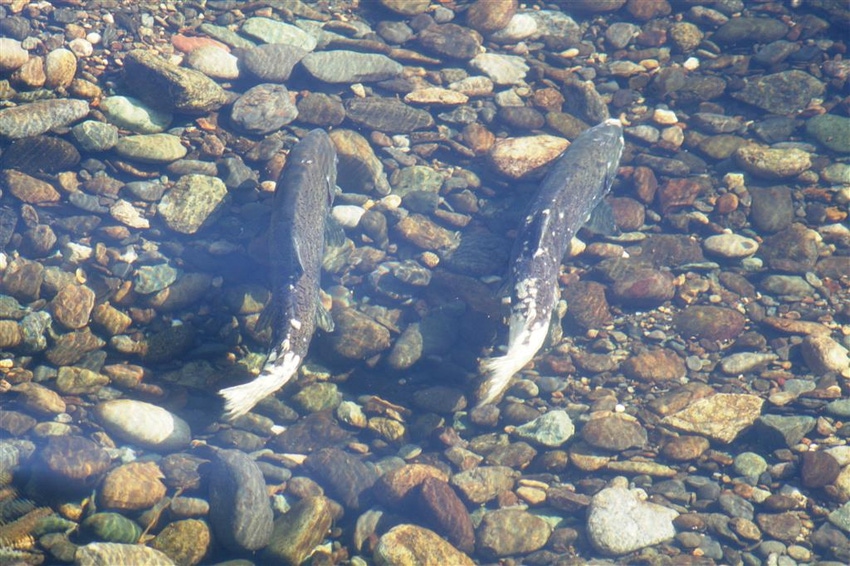
With actions with near-certain political ramifications in California’s heated water battles, two San Joaquin Valley irrigation districts took matters into their own hands to protect the water they claim is their's.
At 1 a.m. Tuesday, April 7, the U.S. Bureau of Reclamation boosted releases from New Melones Reservoir east of Oakdale into the Stanislaus River. The effort was designed to push salmon and steelhead populations into the Delta through a series of pulse flows.
That action was met with a swift response by Oakdale and South San Joaquin irrigation districts to divert those flows into a nearby lake controlled by South San Joaquin Irrigation District (SSJID).
Citing legal precedent to the water and pending action by the State Water Resources Control Board, the two districts sought to capture the releases until clarification could be made later this month by the SWRCB.
New Melones is a 2.4 million acre foot reservoir formed by New Melones Dam on the Stanislaus River. It is operated by the USBR.
It took USBR officials until about 8:30 a.m. Tuesday – over seven hours after releases began – to discover the releases were not making it down the Stanislaus River, according to OID General Manager Steve Knell.
At that point the releases were stopped and a conference call between the parties was scheduled for 10 a.m. Tuesday.
The dust-up started several days earlier when the USBR apparently notified the two districts that it would begin pulse flows to move about 30,000 acre feet of water from New Melones into the Stanislaus River.
Immediately, the districts sent a letter to USBR Mid-Pacific Regional Director David Murillo stating that the water in question was there's and the bureau had no right to take it. Knell said OID was prepared to defend its water rights in court.
Among other things, the letter expresses concerns of potential actions by the SWRCB later in the month that could force the districts to hold back more water in New Melones than is possible.
Meanwhile, local residents are spearheading a petition to call for reduced fish flows because of the drought conditions as farmers begin to question what happens next year if the federal government drains New Melones dry later this year and the following winter is as dry as the last one.
It’s all a matter of simple math. The numbers do not add up.
Both districts hold historic rights to 600,000 acre feet of Stanislaus River Water. Given that the lake in early April held about 545,000 acre feet of water, the districts agreed to instead share 450,000 acre feet from the river. This set in place plans for the first-ever water allocation limits to growers in the 105-year history of OID.
SSJID serves urban and agricultural users in the south end of San Joaquin County.
Genesis of disagreements
Discussions between the two districts earlier this year suggested that their use of 450,000 acre feet of water would draw the reservoir down to 115,000 acre feet of total storage by the end of September, which coincides with the end of the water year, Knell said.
An issue quickly arose prior to the USBR’s water releases when the SWRCB said it wanted 225,000 acre feet held back at the end of the water year, meaning new cutbacks were in order.
This caused a problem for the estimated 73,000 acre feet of water the bureau planned to release from April through September for fish restoration projects. Initially the districts agreed to the amount, but that was before the SWRCB recommendation.
“If the feds want water for pulse flows now, the state can’t ask for more storage in September,” said Knell. “You can’t have it both ways.”
Prior to the bureau’s releases and subsequent diversions by the districts, the State Water Board requested information from the bureau about management of New Melones, indicating its preference for the 225,000-acre-foot recommendation. A state ruling on that recommendation is expected by April 25.
Disagreements arose out of a tentative agreement in late March between the districts, the bureau and the National Marine Fisheries about how the limited water supply in the Stanislaus River basin was to be used this year.
In the tentative agreement, the districts agreed to an early pulse flow at the end of March for steelhead trout. No additional flows were to be sent down river until April’s Sierra snow report was released and the state water board approved the bureau’s request to relax water quality standards in light of the four-year California drought.
In return, the bureau would be able to satisfy pulse flows required under a 2009 biological opinion by the National Marine Fisheries Service.
Instead, federal officials went ahead with the pulse flows Tuesday without consulting the irrigation districts and absent a decision by the SWRCB.
The state estimates there are 29 steelhead in the river and all but six of them already have moved toward the Delta. According to Knell, about 400,000 juvenile salmon are estimated to have moved down the river past Riverbank, near Modesto. Of those, Knell estimates about 98 percent will likely be consumed by predators in the Delta before ever making it to the ocean.
“The loss to predation through the Delta is as great or greater, thus creating the biggest impediment to improving fishery populations,” Knell said.
Meanwhile, a decision on how much water the 2,900 service customers of OID will receive this year is expected to be made by the OID board in late April. The current proposal is to deliver between 24-30 inches of water to some customers and 8-10 inches to the remaining customers.
Roughly half of the district’s 57,000 acres is dedicated to almonds, walnuts and grapes, according to Knell. The rest is pasture land.
About the Author(s)
You May Also Like






